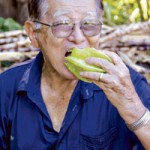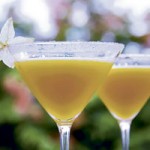Reaching For The Star Fruit
George Mukai’s gardens meander throughout his residential property in Kapahi. There are 25 star fruit trees and five varieties. At 84 years old, Mukai still climbs up 25-foot ladders to harvest fruit. Sometimes he gets help from his son Wayne.
What’s growing: Asparagus, apple bananas, avocado, breadfruit, flowers, Hawaiian chili pepper, honey tangerine, lilikoi, lychee, macadamia nut, mango, mulberry, noni, Okinawan spinach, oriental squash, papaya, pomelo, short yard beans, soursop, star fruit, sweet pepper.
STAR FRUIT
Also known as carambola, star fruit is believed to have originated in Ceylon. It has been cultivated in Southeast Asia and Malaysia for centuries, and is commonly grown in southern China, Taiwan and India. It is also popular in the Philippines, Queensland, Australia, and moderately so in Tahiti, New Caledonia, Netherlands, New Guinea, Guam and Hawaii.
In 1935, seeds from Hawaii were planted at the University of Florida’s Agricultural Research and Education Center in Homestead. A selection from the resulting seedlings was propagated during the 1940s and 1950s.
There are two distinct classes of carambola. The smaller, very sour type is richly flavored and has more oxalic acid. The larger, sweet type is mildly flavored with less oxalic acid.
Season: Small red-and-white flowers appear in June and July on bare branches or at the base of the leaf. Fruit matures in about 60 days. In Hawaii, carambola trees may bear one or two fruit crops per year.
What to look for: The star-shaped fruit is waxy, greenish-yellow to orange in color, 2-5 inches long and elliptical with five distinct wings. Ripe fruits have deep yellow skin and bright orange-yellow flesh. The fruit may have a pronounced, sour oxalic acid odor, and the flavor ranges from very sour to mildly sweet. The sweet varieties rarely contain more than 4 percent sugar.
Optimum sugar levels are achieved at full yellow color, but ripe fruit are more fragile and easily damaged. Fruit is often harvested when it begins to yellow, and will continue to develop color.
Storage: Fruit that is yellow or a very light green will ripen on the counter at room temperature. Don’t refrigerate, as this will stop the ripening process. Once the fruit has turned a golden or yellow color, it is ready to eat. Store ripe carambola in a plastic bag in the refrigerator, and it will keep for almost a week.
Preparation: Carambolas are eaten out-of-hand, sliced and served in salads, or used as a garnish on avocado or seafood. They are cooked in puddings, tarts, stews and curries. In Malaysia, they are often stewed with sugar and cloves, alone or combined with apples. The Chinese cook carambolas with fish. Thais boil the sliced green fruit with shrimp. In Mainland China and Taiwan, carambolas are sliced lengthwise and canned in syrup. In Queensland, the sweeter type is cooked green as a vegetable.
Cross-sections may be covered with honey, allowed to stand overnight, cooked briefly and put into sterilized jars. Some cooks add raisins to give it more flavor.
- At 84, George Mukai still maintains his property. Daniel Lane photos
- The star-shaped fruit
- Eating on the job
- Tiki Tacos’ Tikitini. Daniel Lane photos
Carambola juice is served as a cooling beverage. In Hawaii, the juice of sour fruits is mixed with gelatin, sugar, lemon juice and boiling water to make sherbet. Filipinos often use the juice as a seasoning.
To make jelly, use unripe sweet types, or ripe sour types. Add commercial pectin or other fruit rich in pectin, such as green papaya, together with lemon or lime juice.
Flowers are acidic and added to salads in Java, and made into preserves in India. The leaves have been eaten as a substitute for sorrel.
Tip: Oxalic acid, found in raw star fruit, can be deadly for people with impaired kidney function. Symptoms occur within one to five hours after eating the fruit. Typical symptoms include persistent hiccups, nausea, vomiting, agitation, insomnia, mental confusion and convulsions. Death has occurred in some cases.
Health benefits: In India, the ripe fruit is administered to halt hemorrhages and to relieve bleeding hemorrhoids, and the dried fruit or juice may be taken to counteract fevers. A conserve of the fruit is said to allay biliousness and diarrhea, and to relieve hangovers. A salve is made of the fruit to relieve eye afflictions. In Brazil, carambola is believed to have a beneficial effect in the treatment of eczema. Chinese Materia Medica states, “Its action is to quench thirst, to increase the salivary secretion, and hence to allay fever.”
George Mukai’s produce can be found at: Anahola Fruit Stand, and Kapa‘a Fruit Stand, by Sugar Mill Cupcakes. Mukai’s star fruit is in Nani Moon Mead’s Winter Sun and Ginger Spice blends. Mukai sells most of his produce to Esaki’s Produce. Call 822-4568.
TIKI TACOS’ TIKITINI
Tiki Morales, owner of Tiki Tacos, shares her recipe for a Mexican martini. Star fruit and passion fruit make a zesty combination, perfect for the end of a sultry summer day. A salt-and-sugar rim enhances the flavors. Serves two. • 4 ounces fresh star fruit juice
4 ounces fresh lilikoi juice
4 ounces tequila
2 tablespoons agave or honey
2 tablespoons sugar
2 tablespoons Hawaiian sea salt
ice
Mix salt and sugar on a plate. Run a slice of star fruit around the edge of two martini glasses. Roll the edges in the salt and sugar mixture. Put tequila and agave in a martini shaker, and stir until agave dissolves. Add star fruit and lilikoi juice and four ice cubes. Shake vigorously to chill. Strain into glasses and serve.
Marta Lane is a freelance food writer. For more information visit TastingKauai.com







